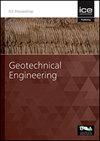真空固结提高软土地基不排水抗剪强度
IF 1.7
4区 工程技术
Q3 ENGINEERING, GEOLOGICAL
Proceedings of the Institution of Civil Engineers-Geotechnical Engineering
Pub Date : 2022-05-31
DOI:10.1680/jgeen.21.00154
引用次数: 0
摘要
本文讨论了利用真空固结法改善软土地基,提高软土地基不排水抗剪强度(Su)的方法。由于软土,特别是泥炭土和有机粘土,具有非常低的Su值,在这些土壤上建造堤防和结构经常引起地面破坏。本课题试验路堤采用真空固结法对泥炭、有机粘土和粘土组成的软基进行了改良,使Su值显著提高,在改良后的地基上可建造高度为10.7 m的路堤而不会造成地面破坏。泥炭和有机粘土的初始Su值均低于粘土的强度,分别为泥炭和有机粘土的48%和59%。然而,真空固结后,这些土壤的最终Su值大大增加,达到粘土最终强度的199%(泥炭)和154%(有机粘土)。结果表明:Su的增大是泥炭和有机粘土较高的归一化不排水抗剪强度(Su/σ ' v,其中σ ' v为有效覆盖层应力)与真空固结独特的加载机制共同作用的结果。在相对狭窄的路堤(如路堤和河堤)中,各向同性固结效应也有助于提高真空固结泥炭土的稳定性。如果已知原地基的(Su/σ ' v)NC和过固结比(OCR),则可以预测真空固结后过固结地基的(Su/σ ' v)OC。本文章由计算机程序翻译,如有差异,请以英文原文为准。
Increasing the Undrained Shear Strength of Soft Ground Improved by Vacuum Consolidation
This paper discusses the use of vacuum consolidation to improve soft ground and increase its undrained shear strength (Su). Since soft soils, particularly peat and organic clay soils, have very low Su values, the construction of embankments and structures on these soils often cause ground failure. For the trial embankment conducted in this research project, soft ground composed of peat, organic clay and clay was improved by using vacuum consolidation, resulting in a significant increase in Su values, and an embankment 10.7 m in height could be constructed on the improved ground without causing ground failure. The initial Su values of the peat and organic clay were lower than the strength of the clay, namely, 48% (peat) and 59% (organic clay) of that of clay. However, after vacuum consolidation of these soils, their final Su values greatly increased to 199% (peat) and 154% (organic clay) of the final strength of clay. It was demonstrated that the increased Su was the result of synergy of the relatively high normalized undrained shear strength (Su/σ′v, where σ′v is the effective overburden stress) of peat and organic clay, and the unique loading mechanism of vacuum consolidation. It was also demonstrated that in case of a relatively narrow embankment (e.g., road embankment and river levee), the effect of isotropic consolidation also contributes to increase the stability of the vacuum consolidated peaty ground. It was also found that if the (Su/σ′v)NC of the original ground and the over-consolidation ratio (OCR) are known, the (Su/σ′v)OC of the given ground over-consolidated by vacuum consolidation can be predicted.
求助全文
通过发布文献求助,成功后即可免费获取论文全文。
去求助
来源期刊
CiteScore
4.40
自引率
4.50%
发文量
68
审稿时长
3 months
期刊介绍:
Geotechnical Engineering provides a forum for the publication of high quality, topical and relevant technical papers covering all aspects of geotechnical research, design, construction and performance. The journal aims to be of interest to those civil, structural or geotechnical engineering practitioners wishing to develop a greater understanding of the influence of geotechnics on the built environment.

 求助内容:
求助内容: 应助结果提醒方式:
应助结果提醒方式:


